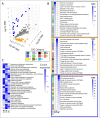Active prokaryotic and eukaryotic viral ecology across spatial scale in a deep-sea brine pool
- PMID: 39021441
- PMCID: PMC11252502
- DOI: 10.1093/ismeco/ycae084
Active prokaryotic and eukaryotic viral ecology across spatial scale in a deep-sea brine pool
Abstract
Deep-sea brine pools represent rare, extreme environments, providing unique insight into the limits of life on Earth, and by analogy, the plausibility of life beyond it. A distinguishing feature of many brine pools is presence of thick microbial mats that develop at the brine-seawater interface. While these bacterial and archaeal communities have received moderate attention, viruses and their host interactions in these environments remain underexplored. To bridge this knowledge gap, we leveraged metagenomic and metatranscriptomic data from three distinct zones within the NEOM brine pool system (Gulf of Aqaba) to reveal the active viral ecology around the pools. We report a remarkable diversity and activity of viruses infecting microbial hosts in this environment, including giant viruses, RNA viruses, jumbo phages, and Polinton-like viruses. Many of these form distinct clades-suggesting presence of untapped viral diversity in this ecosystem. Brine pool viral communities exhibit zone-specific differences in infection strategy-with lysogeny dominating the bacterial mat further away from the pool's center. We linked viruses to metabolically important prokaryotes-including association between a jumbo phage and a key manganese-oxidizing and arsenic-metabolizing bacterium. These foundational results illuminate the role of viruses in modulating brine pool microbial communities and biogeochemistry through revealing novel viral diversity, host associations, and spatial heterogeneity in viral dynamics.
Keywords: NEOM brine pools; brine pool viruses; deep-sea viruses; marine viral diversity; marine virus ecology; virus–host interactions.
© The Author(s) 2024. Published by Oxford University Press on behalf of the International Society for Microbial Ecology.
Conflict of interest statement
The authors declare no conflict of interest.
Figures








Similar articles
-
Sedimentary porewaters record regional tectonic and climate events that perturbed a deep-sea brine pool in the Gulf of Aqaba, Red Sea.Sci Total Environ. 2024 Feb 20;912:168804. doi: 10.1016/j.scitotenv.2023.168804. Epub 2023 Nov 28. Sci Total Environ. 2024. PMID: 38036117
-
Lower viral evolutionary pressure under stable versus fluctuating conditions in subzero Arctic brines.Microbiome. 2023 Aug 7;11(1):174. doi: 10.1186/s40168-023-01619-6. Microbiome. 2023. PMID: 37550784 Free PMC article.
-
Viral Ecogenomics of Arctic Cryopeg Brine and Sea Ice.mSystems. 2020 Jun 16;5(3):e00246-20. doi: 10.1128/mSystems.00246-20. mSystems. 2020. PMID: 32546670 Free PMC article.
-
Novel Enzymes From the Red Sea Brine Pools: Current State and Potential.Front Microbiol. 2021 Oct 27;12:732856. doi: 10.3389/fmicb.2021.732856. eCollection 2021. Front Microbiol. 2021. PMID: 34777282 Free PMC article. Review.
-
Ecology of prokaryotic viruses.FEMS Microbiol Rev. 2004 May;28(2):127-81. doi: 10.1016/j.femsre.2003.08.001. FEMS Microbiol Rev. 2004. PMID: 15109783 Review.
Cited by
-
Darkness to Discovery: A Comprehensive Mini-Review on Culturable and Non-Culturable Microbial Diversity from Deep Sea.Microb Ecol. 2025 Jul 18;88(1):77. doi: 10.1007/s00248-025-02527-y. Microb Ecol. 2025. PMID: 40679638 Free PMC article. Review.
References
-
- Anschutz P, Blanc G, Chatin Fet al. Hydrographic changes during 20 years in the brine-filled basins of the Red Sea. Deep-Sea Res I Oceanogr Res Pap 1999;46:1779–92. 10.1016/S0967-0637(99)00019-9 - DOI
-
- Schardt C. Hydrothermal fluid migration and brine pool formation in the Red Sea: the Atlantis II deep. Mineral Deposita 2016;51:89–111. 10.1007/s00126-015-0583-2 - DOI
-
- Ross DA, Hunt JM. Third brine pool in the Red Sea. Nature 1967;213:687–8. 10.1038/213687a0 - DOI
-
- Backer H, Schoell M. New deeps with brines and metalliferous sediments in the Red Sea. Nat Phys Sci 1972;240:153–8. 10.1038/physci240153a0 - DOI
LinkOut - more resources
Full Text Sources
Miscellaneous

